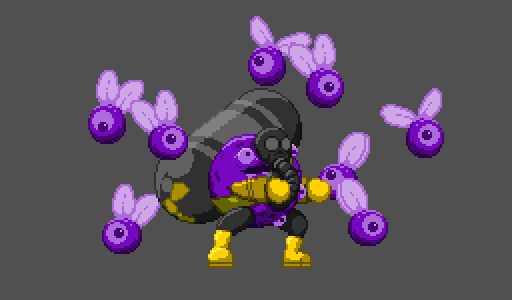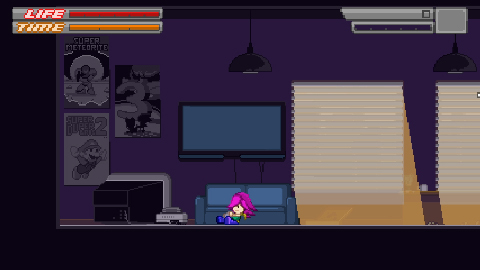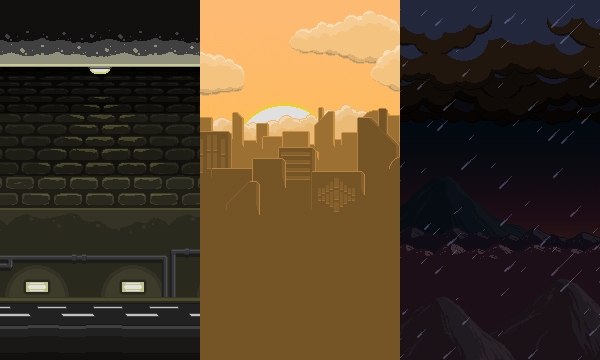Time for something a little different. I’d like to discuss my approach to making Bleed 2, and how I’m attempting to develop it in a way that maximizes both my enthusiasm for work and the quality of the game — two things that can really suffer during long development cycles.

Bleed 2 has existed in some form or another for almost two years now — I actually have a back-up from Jan 1st 2013, when I was first re-designing Wryn’s sprites . Back then, it wasn’t “Bleed 2” — it wasn’t really anything, just me having fun and working on my art between other projects. But the more I played with it, the more I thought about it and the more it seemed like there could actually be a second Bleed. The problem is, there are some major hurdles that come with a large undertaking like this. I’m not sure if the experience is universal, but I suspect it may be.
It’s the easiest thing in the world to get excited about an idea, but that initial excitement only takes you so far. You ride the high for a while — you lay the foundation, you make a couple of test levels and some enemies — all these fresh, new things are coming together! Your dreams are being made manifest and you’re on top of the world. But the more you accomplish, the less instant the gratification becomes. The initial burst of enthusiasm eventually fades, and the enormity of the task before you stretches out for what seems like eternity — you still have an entire game left to realize. At this point, completing the game becomes a labour of love. It’s worth it in the end, unquestionably, but in the thick of it motivation takes a serious hit, and quality can really suffer as a result.

Having experienced this many times, I tried to approach Bleed 2 with a plan that would maximize and make consistent my motivation and enjoyment — and hopefully, as a result, the quality of the game. This required a bit of an analysis of my skills and preferences — essentially, areas of production where I was likely to gain or lose motivation. For example, I’m not an adept artist; creating visual assets is often a lengthy and frustrating process for me, and on top of that I’m colour-deficient. On the other hand, I love every (non-art) aspect of creating bosses, especially fine-tuning their values in code to be extra satisfying to fight.
So first, I tried to front-load as much of the negative stuff as possible, taking advantage of that initial wave of excitement to maximize my enthusiasm for undesirable tasks. I spent the first few months doing nothing but environment art — the frustrations were still there, but the excitement of “BUT THINK OF HOW COOL IT WILL BE WHEN IT’S DONE” definitely helped keep me going. By the time I finished it all I was definitely burnt out, but super-relieved that it was done.

Next, I allowed myself to work on bosses — not just one or two, but ALL of them. I mean, I worked on them generally one at a time, but it was all bosses all the time from that point on for months. I got to experience the high of creating a boss, and then ride it as much as I could into creating the art for the next one.
I tried to keep going in that manner — giving myself reasons to be excited, and then using the excitement to push through areas of development I didn’t enjoy as much. Eventually I arrived where I am now — the a process of stitching together the environments and bosses I’ve finished to create the final game. It’s not quite as easy or simple as that makes it sound — there’s still so much to do, including level layouts, set-pieces, cinematics, audio, extras, menus, etc… but what’s most important is: the core of the game is done, and locked in at a level of quality I’m comfortable with.
Motivation inevitably rises and falls, especially over long periods of time, but I’d like to think this process has helped make the lows less low, and the highs more frequent. I continue to save a few tasks I know I enjoy doing for later, like balancing the bosses, so I still have things to anticipate going forward when the tank is running low. With so many pieces done and ready to be put in-game, watching it all come together relatively quickly is also providing its own kind of excitement.
![]()
Lastly, some downsides of my approach to consider:
-It may only be useful if you have a really developed idea of what your game is going to be — there’s no point in front-loading environment art if you’re not positive what your environments are, for example. Since the game was on the back-burner for the majority of 2013, you could say I basically gave Bleed 2 a year of pre-production, which helped make this approach worthwhile.
-It is impossible to meaningfully hype your game in this way. For the majority of two years I’ve had nothing I could really show, just bosses in test rooms and background art. Yeah, I guess I could have showed off some of the art, and occasionally I did, but you aren’t gonna get a trailer out of that. You aren’t gonna get a demo out of that.
-Motivation can also wane here if you lose sight of the big picture. This approach was focused on maximizing work quality and personal enthusiasm, but it’s taken a long time for it to materialize into something you might actually call a game and be able to share with people.
Thanks for reading all that if you made it this far. I hope it managed to be interesting!
